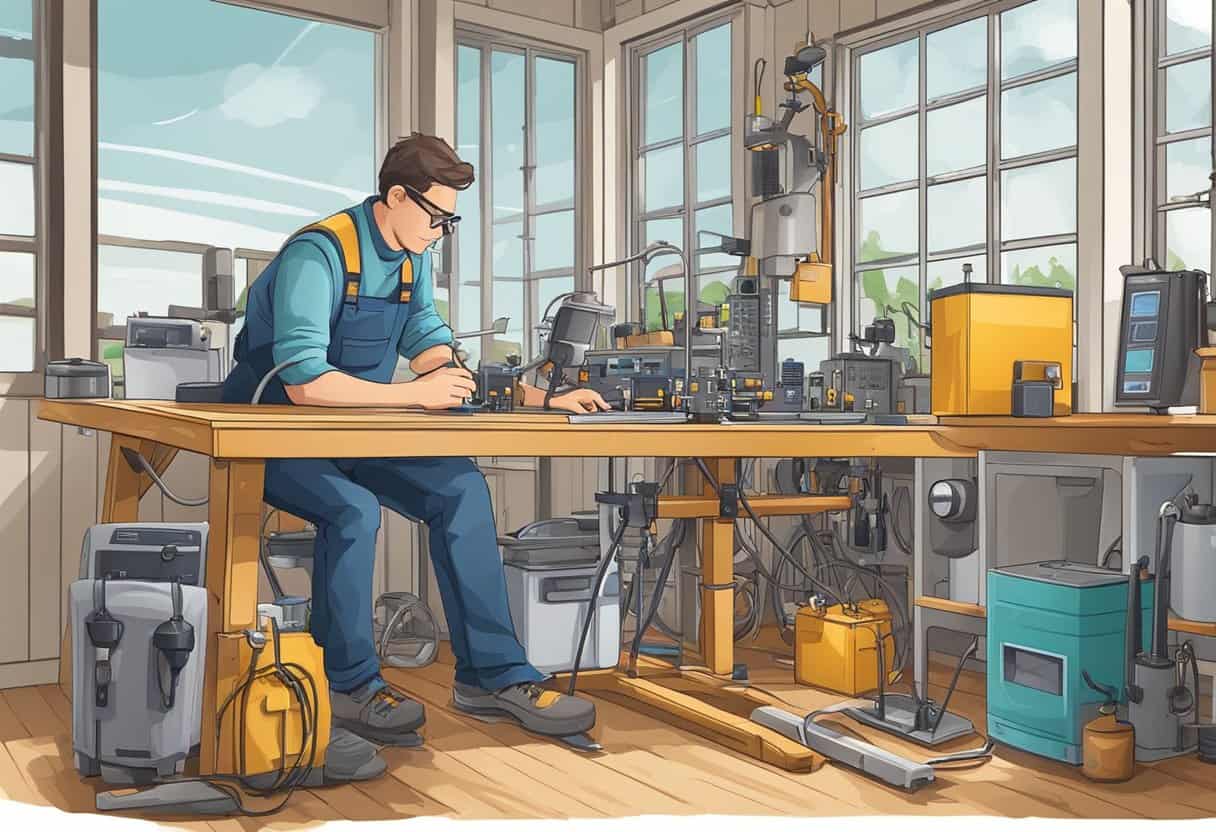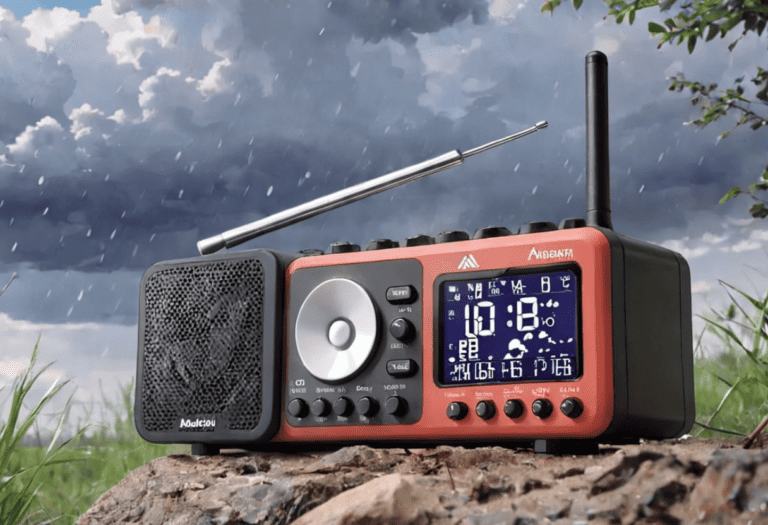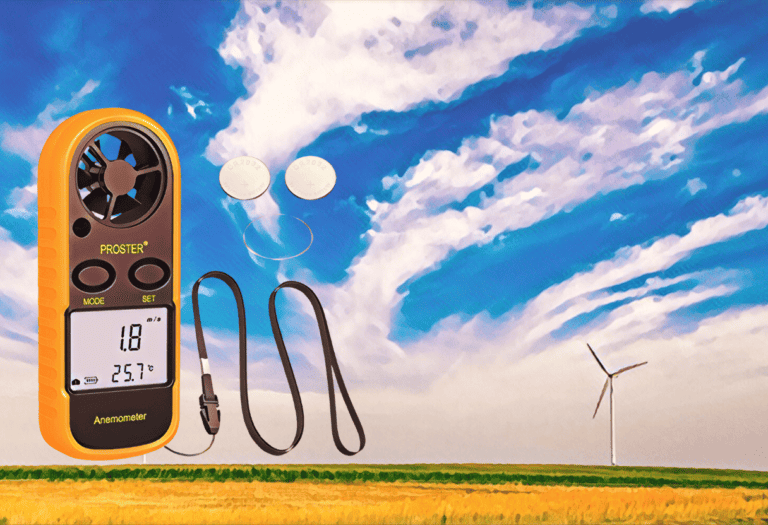Maintaining a home weather station is an engaging way to keep track of the climate around your property and contributes to a larger network of meteorological data.
To get the most accurate and reliable readings, regular upkeep of your personal weather station is crucial. By tending to routine inspections, calibration, and addressing environmental factors, you can ensure that your weather station operates at peak performance.
Selecting an optimal location for your weather station is the foundation for precise data collection, minimizing potential obstructions and interference. After installation, you’ll need to periodically clean and calibrate sensors, troubleshoot any technical issues, and stay informed about the latest operational guidance specific to your device’s brand.
Connectivity is also a key factor, as it enables your station to transmit data for external use and receive updates that might improve functionality.
To maintain a home weather station, ensure it’s correctly placed away from obstructions, regularly clean and calibrate sensors, check and replace batteries, and protect it from extreme weather. Periodic checks for software updates and data accuracy are crucial. Proper maintenance ensures reliable and accurate weather data.
Choosing the Right Location
Selecting an optimal site is crucial for accurate data from your home weather station. It ensures reliable measurements free from environmental biases that can skew results.
Assessing the Environment for Installation
Before installing your weather station, critically evaluate the immediate surroundings. Ideally, the site should represent typical conditions of your area without being altered by unusual topographical or man-made features. You must consider factors like the typical wind direction, exposure to sunlight, and the presence of vegetation.
Siting Your Weather Station
For accurate atmospheric readings, proper siting of your weather station is essential. Ensure it’s at least 4-6 feet above the ground for wind and temperature measurements. If your unit includes a rain gauge, it should be placed in an open area where it can catch precipitation unimpeded.
Avoiding Obstructions and Reflective Surfaces
Keep the station away from obstructions like buildings and trees that can cause wind eddies or block rain. Also, be wary of reflective surfaces that could amplify solar radiation, potentially affecting temperature readings. Utilize a radiation shield for the thermometer to protect it from these temperature biases. This is crucial for maintaining the accuracy of your home weather stations.
Setting Up Your Home Weather Station
Successful installation of your home weather station hinges on following a specific procedure, ensuring stable mounting, and establishing reliable power and data connections.
Installation Procedure
You should start by selecting an appropriate location for your sensor suite. This spot must have unobstructed airflow and be distanced from any large objects that might affect readings, like buildings or trees. Typically, your sensors will need to be mounted at least 4–6 feet above the ground. To ensure accuracy, refer to the manufacturer’s guidelines for the height and orientation of the sensors.
Securing the Mounting Pole
Once you have the location, you’ll need to focus on setting up the mounting pole securely. It is vital that this pole is level and stable, as the accuracy of some sensors, like wind measurement devices, can be adversely affected by even a slight tilt. If you’re installing into the ground, you might need to set the pole in concrete to guarantee stability. For installations on a structure, such as a rooftop, ensure the brackets and fasteners are well-suited for the material of your structure (e.g., wood, metal).
Connecting to Power and Data Cables
Lastly, your station will require connection to a power supply and data cables. For the power supply, you might choose between a connection to your home’s electricity, if your model is not solar-powered, or ensure the batteries are properly installed if it is. Manage the data cables carefully by securing them along the pole and protected from the elements, or, if your station is wireless, by following the procedures to sync with your display console or online platform. The correct installation of cables is crucial for your weather station to function effectively and deliver precise readings.
Routine Inspections and Maintenance

Conducting routine inspections and maintaining your home weather station is crucial for accurate data collection and long-term reliability. Paying close attention to sensor functionality, power management, and sensor cleanliness will ensure optimal performance.
Checking Sensor Functionality
You should verify sensor accuracy regularly to ensure they provide reliable data. This involves comparing your weather station’s readings with local official measurements or using a calibrated reference tool. If discrepancies arise, recalibration might be necessary. Consistently monitor sensor output for signs of drift or sudden changes that could indicate a malfunction.
Batteries and Power Management
Your weather station relies heavily on batteries for uninterrupted operation. Regularly check and replace batteries as needed. If your station uses solar panels, ensure they are free from debris and functioning efficiently. Keep backup batteries on hand, preferably lithium batteries, as they perform better across a range of temperatures and have a longer shelf-life.
Cleaning the Sensors Properly
Maintaining cleanliness is paramount for sensor accuracy. Gently clean the sensors using a brush or cloth to remove debris, dust, or cobwebs. Avoid using harsh cleaning agents as they can damage sensitive components. Check the manufacturer’s instructions to confirm the recommended cleaning procedure and frequency for your maintenance schedule.
Calibration and Accuracy
Maintaining the calibration and accuracy of your home weather station is crucial for reliable data. Consistent calibration checks and ensuring accurate readings are the pillars of dependable weather monitoring.
Regular Calibration Checks
To keep your weather station functioning correctly, regular calibration checks are essential. You should schedule these checks at consistent intervals, typically every six months to a year depending on the manufacturer’s recommendation. During calibration checks, compare your station’s readings with a known reference point or a professionally calibrated device. If discrepancies are found, a recalibration may be necessary to align the readings with the standard measurements.
- Frequency: Every 6-12 months
- Comparison: Against a calibrated reference
- Action: Recalibrate if necessary
Ensuring Accurate Readings
For your weather station to yield accurate readings, certain practices should be followed:
- Location: Position your weather station away from obstructions and reflective surfaces.
- Cleaning: Keep sensors clean from debris and dirt.
- Batteries: Replace batteries regularly to prevent power-related inaccuracies.
- Sensor Checks: Monitor sensor function and replace them if they show signs of deterioration.
By methodically attending to these aspects, you’ll ensure the accuracy of your weather station’s data. Remember that accurate readings are the foundation of precise weather predictions and analysis.
Sensor-Specific Maintenance
Maintaining your home weather station involves regular checks and cleaning of individual sensors to ensure accurate readings. Each type of sensor requires its own particular maintenance routine to function optimally.
Temperature and Humidity Sensors
Your temperature and humidity sensors are crucial for precise climate data. For temperature sensors, ensure they’re cleared of debris and shaded from direct sunlight for accurate readings. Humidity sensors often need to be cleaned with a soft brush and distilled water to remove any buildup that could impair their responsiveness to moisture changes.
Temperature Sensors
- Keep clear of debris
- Shelter from direct sunlight
Humidity Sensors
- Clean gently with a soft brush
- Use distilled water to remove buildup
Rain Gauge and Tipping Bucket
The rain gauge collects and measures rainfall readings. Keep it free from obstructions and regularly empty it to prevent water stagnation and algae growth. The tipping bucket within needs to be checked for smooth operation without any residue hindering the tipping mechanism.
Rain Gauge
- Remove obstructions such as leaves or debris
- Regularly empty to prevent water stagnation
Tipping Bucket
- Ensure the tipping mechanism is unobstructed
- Check for residue and clean as necessary
Wind Sensors and Direction Readings
For accurate wind speed and direction data, anemometers and wind vanes must be unobstructed and securely mounted. Lubricate the bearings in the anemometer periodically for smooth rotation. Wind vanes should be checked for alignment and freedom of movement to properly indicate wind direction.
Anemometers
- Lubricate bearings for continued smooth operation
- Remove any nests or debris
Wind Vanes
- Check for proper alignment
- Ensure free movement without blockages
Dealing With Environmental Factors
Maintaining your home weather station involves safeguarding it against various environmental factors. It’s vital that you consider the impact of weather conditions and local wildlife to ensure accurate data collection and longevity of your equipment.
Protecting from Weather Conditions
Your weather station’s sensors need to be protected against the elements they’re measuring. For instance, rain can corrode unprotected equipment. To counter this, ensure that all sensors are housed within weather-resistant enclosures and that any exposed wiring is insulated and run through conduits. For solar radiation sensors, periodically clean the coverings to prevent inaccuracies caused by dust and dirt accumulation.
- Temperature and Humidity Sensors: Place these sensors in a ventilated radiation shield. This will protect them from direct sunlight and precipitation while allowing air to flow freely.
- Wind Sensors: Should be positioned away from obstructions, high enough to avoid turbulent air, but securely installed to withstand strong winds and falling branches.
Preventing Damage from Animals and Pests
Animals and pests can inadvertently damage your weather station:
- Birds often perch on sensor arrays, potentially misaligning them or leaving droppings that can interfere with readings. Installing bird spikes can deter them from landing on your equipment.
- Bugs are attracted to the electrical components and warmth of your station. Use environmentally-friendly insect repellents and regularly check the housing for infestations.
Take these steps to ensure your home weather station can withstand your local climate and environmental challenges, providing you with reliable data throughout its service life.
Advanced Troubleshooting and Repairs
When you’re tasked with maintaining a home weather station, addressing the complexity of advanced troubleshooting and repairs is crucial. By skillfully diagnosing common issues, replacing defective parts, and upgrading components, you enhance the station’s longevity and performance.
Diagnosing Common Issues
To ensure regular maintenance contributes effectively to your weather station’s longevity, you need to identify problem areas with precision. Start by examining the station’s bearings and mesh diffusers, as these elements can succumb to wear over time. Listen for unusual noises or check for inconsistent readings, which might indicate mechanical hindrances. For accurate diagnostics, compare current data with historical records to pinpoint irregularities.
Replacement of Worn or Broken Parts
Routine maintenance tasks include replacing worn or broken components that affect the reliability and accuracy of your weather station. Components like anemometer bearings and wind vane potentiometers can impact a system’s ability to measure effectively. Always follow the manufacturer’s guidelines to ensure that you get the right parts and install them correctly.
- Bearings: Ensure they are properly lubricated and free of debris.
- Fan: Inspect for optimal rotation and replace if it’s malfunctioning.
- Sensor Mesh: Check for clogs and damage that can affect reading accuracy.
Upgrading Components for Better Performance
Upgrading key components can significantly extend your weather station’s lifespan and can be a worthwhile investment for improved data accuracy and reliability. Look for enhanced versions of important parts such as weather-proof sensor covers or high-quality bearings designed for longevity. An upgrade might be pertinent if you recognize a pattern of consistent issues or want to preempt potential malfunctions.
- High-Performance Bearings: They offer reduced friction and increased durability.
- Sensitive Mesh Diffusers: These can provide more accurate humidity and temperature readings.
By following these advanced troubleshooting and repair steps, your home weather station should remain in top condition, ready to provide the precise climate data you rely on.
Monitoring and Recording Data
To ensure the consistent performance of your home weather station, you need to focus on two key aspects: how weather data is captured and how it is preserved. Both steps are crucial for accurate tracking of environmental conditions and are integral to weather station maintenance.
Capturing Weather Data
Your home weather station is an essential tool in collecting weather information. To capture data accurately, you’ll want to regularly check sensor alignment and clear any obstructions that could affect readings. For instance, rain gauges should be free from debris and wind sensors should be unobstructed and positioned according to the guidelines established by the National Weather Service (NWS) for NWS reporting stations.
- Temperature and Humidity: Should be measured in shaded areas to avoid direct sunlight affecting the sensors.
- Wind Readings: Must be taken at a standard height of 10 meters, away from obstructions.
- Precipitation: Measure using a gauge placed in an open area to prevent blockage from surrounding objects.
Backing Up Your Data Regularly
Regular backups of your weather data are as important as the initial capture. Your weather station’s data logs provide not just historical records but also help in predictive analysis for future conditions.
- Manual Backups: Take time every week to download your data to an external drive or cloud service.
- Automatic Backups: Set your system to automatically send data to a secure location. This can protect against data loss due to power outages or equipment failure.
By faithfully capturing and backing up your weather station data, you’ll maintain the accuracy of your records and the integrity of your home weather station. This vigilance in weather station maintenance ensures the longevity of your equipment and the reliability of the weather data you collect.
Brand-Specific Guidance
Maintaining your home weather station is crucial to ensuring accurate data collection and longevity of the device. Each brand has its specific requisites and best practices to keep in mind.
Maintenance Tips for Davis Instruments
For owners of the Davis Vantage Pro2 or Vantage Vue, routine maintenance ensures your station remains reliable. Make sure to:
- Clean the rain collector of your Davis Vantage Pro2 regularly, removing debris and insects that may affect rainfall measurements.
- Check and replace the sensor suite’s lithium battery every 2 years or as needed for your Davis Instruments weather station models, including the Vantage Pro2 and Vantage Vue.
Acurite Weather Stations Care
When it comes to maintaining Acurite weather stations:
- Gently clean your device’s external parts with a mild detergent, ensuring no buildup affects its sensors.
- For Acurite models like the 5-in-1 weather station, calibrating the rain gauge for accuracy is advised; follow the brand’s specific instructions to do so.
Ambient Weather and Other Brands
Ambient Weather stations and other personal weather stations require:
- Regular calibration, especially if you live in an area with significant weather fluctuations. Refer to your model’s manual for specific guidance.
- Ensure the anemometer spins freely on models like those from Ambient Weather, and check for obstructions regularly.
Each weather station, including those from Davis Instruments, Acurite, or Ambient Weather, benefits significantly from preventive care and appropriate upkeep based on the manufacturer’s instructions.
Supplementary Equipment and Accessories
Enhancing the capabilities of your home weather station can be achieved by incorporating various supplementary equipment and accessories. Selecting the appropriate add-ons can significantly improve your station’s accuracy and functionality.
Using Additional Sensors
Your weather station can be improved with additional sensors, such as leaf wetness sensors, which are pivotal for gardeners monitoring plant diseases, or UV sensors to measure solar radiation. For more precise wind data, consider upgrading to a sonic anemometer, which can provide accurate wind speed and direction without moving parts.
- Leaf Wetness Sensors: These help in determining the risk of plant disease.
- UV Sensors: Useful for measuring the sun’s UV radiation levels.
- Sonic Anemometers: Offer more precise measurements of wind speed and direction.
Mounting Brackets and Hardware
To ensure stable and secure installation of your weather station, use durable mounting brackets and hardware. Properly installed brackets resist environmental factors like wind and rain, and placing them at optimal height can lead to more accurate measurements.
- Mounting Brackets: Select brackets that are made to withstand your local weather conditions.
Weather Station Expansion Kits
If you’re looking to extend the abilities of your existing system, weather station expansion kits can be an efficient solution. These kits may include replacement sensors or solar panels to ensure continuous operation. When selecting an expansion kit, verify compatibility with your current setup to integrate seamlessly.
- Solar Panels: Useful for powering stations and sensors, reducing the need for battery changes.
- Expansion Kits: Often includes several new sensors to further diversify data collection.
Legal and Safety Considerations
When maintaining a home weather station, it’s crucial to be aware of and adhere to all applicable legal regulations while ensuring safe operation practices to prevent any hazards.
Adhering to Local Regulations
You must familiarize yourself with local laws and ordinances that may govern the installation and use of a weather station. In some areas, the height and location of structures such as weather stations are subject to zoning laws. It is important to obtain necessary permissions to avoid legal complications. You should also inform yourself about any potential technical or legal challenges that may be associated with the data obtained from your weather station.
Ensuring Safe Operation
For safety, it’s essential to properly install your weather station, securing any loose parts that might cause injury or damage, especially during harsh weather conditions. You should periodically inspect your weather station checking for wear and tear or electrical issues that could pose a risk. Check the manufacturer’s manual for specific maintenance guidelines to ensure operation safety. Reflect on the importance of firefighter safety while installing weather stations, especially in rural or prone-to-wildfire areas. Regular maintenance reduces the risk of falling objects and ensures reliable data collection.
Maintaining Connectivity
Maintaining robust connectivity for your home weather station is crucial for uninterrupted data collection and analysis. Ensuring stable network connections and managing firmware and software updates are key to the reliable performance of your system.
Ensuring Stable Network Connections
Your home weather station relies on a consistent network connection to transmit data. Here’s how you can ensure that your station stays connected:
- Check Network Hardware: Regularly inspect routers, extenders, and other network devices for signs of wear and tear. Replace any faulty hardware promptly.
- Network Placement: Position your weather station and network hardware to minimize obstructions and maximize signal strength. Materials such as metal or concrete can block signals, so it’s wise to place your station within a clear line of sight to your router.
- For enhancing the resilience of your network in remote or challenging environments, consider methods used in sensor network implementation such as deploying redundant nodes to act as relays.
Managing Firmware and Software Updates
Keeping your system’s firmware and software up-to-date is essential for enhanced functionality and security. To effectively manage updates for your home weather station:
- Regular Updates: Set a schedule to check for updates from the device manufacturer. Enabling automatic updates can keep your station running smoothly without the need to manually apply fixes and improvements.
- Download from Trusted Sources: Always ensure you download firmware and software from the manufacturer’s official website or authorized distributors to maintain the integrity of your home weather station.
Remember, consistent network connectivity and up-to-date firmware and software are the backbones of a reliable home weather station.
Long-Term Considerations
When maintaining a home weather station, it’s important to think ahead. Consider not only how the station will serve current needs but also how it might need to adapt as technology advances and as components approach the end of their lifespan.
Planning for Future Expansion
Your home weather station is a dynamic tool, and as your interest or need for detailed meteorological data grows, so too might your setup. When initially setting up your station, think strategically about modular designs that allow for easy addition of new sensors or capabilities. For instance, if you decide that measuring solar radiation becomes important to your analyses, having a scalable system will save you time and resources. Also, integrate data management systems that can handle increased volumes from future expansions. Choose software that offers compatibility with a range of sensors or the ability to upgrade to a more sophisticated system.
Considering Lifecycle and Disposal
Every component of your weather station has a lifespan. Regular maintenance checks will help prolong this, but eventual replacement is inevitable. Familiarize yourself with the manufacturer’s guidelines for proper care and the average lifecycle of the products you’re using. When it’s time for disposal, do so in an environmentally responsible manner. Many components, such as electronic sensors, may contain materials that require special disposal methods to prevent environmental harm. Similarly, consider the recyclability of each component. By choosing parts that are easily recyclable, you ensure the disposal process is more sustainable. Keep documentation of your weather station’s parts to assist in responsible end-of-life management.
Benefits of Well-Maintained Stations
Maintaining your weather station meticulously ensures the data collected are of the highest quality. This precision directly influences the efficacy of local weather prediction and enriches the broader scope of scientific research.
Improving Weather Prediction
A well-maintained weather station plays a pivotal role in enhancing weather prediction accuracy at a local scale. By ensuring that the sensors are calibrated, and the data is regularly checked for consistency, you provide reliable information that can be used to forecast weather more precisely. This leads to better preparedness for any weather-related events, be it a storm or a heatwave.
Contributing to Science and Research
Your well-kept station also contributes substantially to science and research. Every bit of data can be valuable in building larger datasets that scientists use to understand climate patterns and changes. By maintaining your station and sharing your data, you become part of a global network of citizen scientists whose contributions are vital in the study of meteorology and climatology.
Conclusion
Maintaining your home weather station is crucial to ensure the accuracy and longevity of the equipment. Regular checks and upkeep will allow you to enjoy precise weather data and make informed decisions.
- Inspect Sensors: Periodically clean your sensors to prevent dirt and debris from affecting readings.
- Battery Replacement: Replace batteries annually or as indicated by the manufacturer to avoid power interruptions.
- Firmware Updates: Keep the system’s firmware up-to-date to improve functionality and fix bugs.
- Calibration Checks: Calibrate sensors as necessary to ensure data accuracy.
- Physical Shielding: Ensure the station is shielded from direct sunlight and precipitation to prevent damage to components.
- Documentation: Keep a record of maintenance activities for future reference.
By following these steps and consulting the manual from your weather station’s manufacturer, your home weather station will serve as a reliable source of meteorological information. Prioritize regular maintenance to aid in its optimal performance.
Frequently Asked Questions
Maintaining your home weather station is crucial for accurate data collection and prolongation of the device’s lifespan. These FAQs will guide you through the basics of care and troubleshooting.
What are the recommended cleaning procedures for a home weather station?
To keep your weather station in top condition, gently wipe the exterior components with a damp cloth. Remove any debris from rain gauges or other sensors carefully to avoid damage.
What is the typical lifespan of a home weather station?
A home weather station typically lasts between 5 to 10 years, depending on the model and how well it is maintained.
What are common troubleshooting steps for an AcuRite weather station?
For common AcuRite weather station issues, first verify that the power source is working. Then, check whether the sensors are clean and not obstructed. Resetting the device can also resolve many problems.
How often should the moving parts of a home weather station be lubricated?
Lubricate any moving parts, such as the anemometer on your weather station, at least once a year or as recommended by the manufacturer to ensure smooth operation.
What are the best practices for calibrating a home weather station?
Calibrate your home weather station by cross-referencing its readings with known reliable sources, adjusting settings as necessary, and following the manufacturer’s instructions carefully.
How can one ensure the sensors of a home weather station are providing accurate readings?
For accurate sensor readings, place your weather station in a location free from obstructions and artificial temperature influences. Regularly check and maintain the sensors as directed in the product manual.







